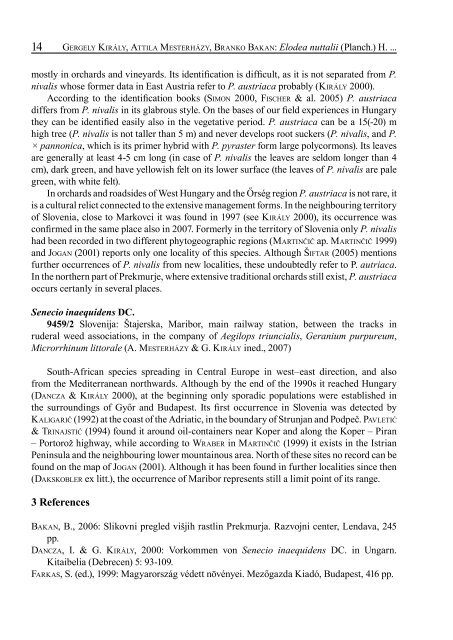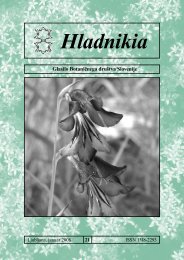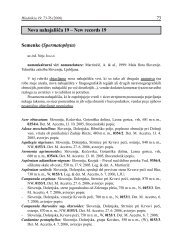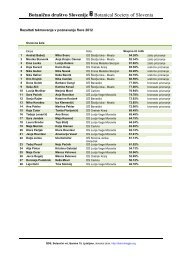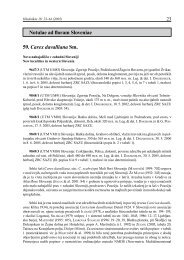PDF formatu - BotaniÄno druÅ¡tvo Slovenije
PDF formatu - BotaniÄno druÅ¡tvo Slovenije
PDF formatu - BotaniÄno druÅ¡tvo Slovenije
Create successful ePaper yourself
Turn your PDF publications into a flip-book with our unique Google optimized e-Paper software.
14<br />
Ge r g e ly Ki r á ly, At t i l a Me st e r h á z y, Br a n k o Ba k a n: Elodea nuttalii (Planch.) H. ...<br />
mostly in orchards and vineyards. Its identification is difficult, as it is not separated from P.<br />
nivalis whose former data in East Austria refer to P. austriaca probably (Ki r á ly 2000).<br />
According to the identification books (Sim o n 2000, Fi s c h e r & al. 2005) P. austriaca<br />
differs from P. nivalis in its glabrous style. On the bases of our field experiences in Hungary<br />
they can be identified easily also in the vegetative period. P. austriaca can be a 15(-20) m<br />
high tree (P. nivalis is not taller than 5 m) and never develops root suckers (P. nivalis, and P.<br />
× pannonica, which is its primer hybrid with P. pyraster form large polycormons). Its leaves<br />
are generally at least 4-5 cm long (in case of P. nivalis the leaves are seldom longer than 4<br />
cm), dark green, and have yellowish felt on its lower surface (the leaves of P. nivalis are pale<br />
green, with white felt).<br />
In orchards and roadsides of West Hungary and the Őrség region P. austriaca is not rare, it<br />
is a cultural relict connected to the extensive management forms. In the neighbouring territory<br />
of Slovenia, close to Markovci it was found in 1997 (see Ki r á ly 2000), its occurrence was<br />
confirmed in the same place also in 2007. Formerly in the territory of Slovenia only P. nivalis<br />
had been recorded in two different phytogeographic regions (Ma rt i n č i č ap. Ma rt i n č i č 1999)<br />
and Jo g a n (2001) reports only one locality of this species. Although Ši f ta r (2005) mentions<br />
further occurrences of P. nivalis from new localities, these undoubtedly refer to P. autriaca.<br />
In the northern part of Prekmurje, where extensive traditional orchards still exist, P. austriaca<br />
occurs certanly in several places.<br />
Senecio inaequidens DC.<br />
9459/2 Slovenija: Štajerska, Maribor, main railway station, between the tracks in<br />
ruderal weed associations, in the company of Aegilops triuncialis, Geranium purpureum,<br />
Microrrhinum littorale (A. Me st e r h á z y & G. Ki r á ly ined., 2007)<br />
South-African species spreading in Central Europe in west–east direction, and also<br />
from the Mediterranean northwards. Although by the end of the 1990s it reached Hungary<br />
(Da n c z a & Ki r á ly 2000), at the beginning only sporadic populations were established in<br />
the surroundings of Győr and Budapest. Its first occurrence in Slovenia was detected by<br />
Ka l i g a r i č (1992) at the coast of the Adriatic, in the boundary of Strunjan and Podpeč. Pav l e t i ć<br />
& Tr i n a j s t i ć (1994) found it around oil-containers near Koper and along the Koper – Piran<br />
– Portorož highway, while according to Wr a b e r in Ma rt i n č i č (1999) it exists in the Istrian<br />
Peninsula and the neighbouring lower mountainous area. North of these sites no record can be<br />
found on the map of Jo g a n (2001). Although it has been found in further localities since then<br />
(Da k s k o b l e r ex litt.), the occurrence of Maribor represents still a limit point of its range.<br />
3 References<br />
Ba k a n, B., 2006: Slikovni pregled višjih rastlin Prekmurja. Razvojni center, Lendava, 245<br />
pp.<br />
Da n c z a, I. & G. Ki r á ly, 2000: Vorkommen von Senecio inaequidens DC. in Ungarn.<br />
Kitaibelia (Debrecen) 5: 93-109.<br />
Fa r k a s, S. (ed.), 1999: Magyarország védett növényei. Mezőgazda Kiadó, Budapest, 416 pp.


